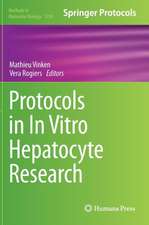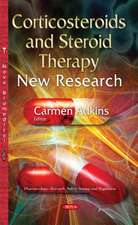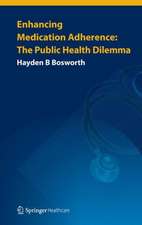Antibacterial Chemotherapeutic Agents
Autor S. L. Daxen Limba Engleză Hardback – 31 oct 1996
| Toate formatele și edițiile | Preț | Express |
|---|---|---|
| Paperback (1) | 1222.49 lei 43-57 zile | |
| SPRINGER NETHERLANDS – 20 sep 2011 | 1222.49 lei 43-57 zile | |
| Hardback (1) | 1228.62 lei 43-57 zile | |
| SPRINGER NETHERLANDS – 31 oct 1996 | 1228.62 lei 43-57 zile |
Preț: 1228.62 lei
Preț vechi: 1498.31 lei
-18% Nou
Puncte Express: 1843
Preț estimativ în valută:
235.10€ • 246.08$ • 195.67£
235.10€ • 246.08$ • 195.67£
Carte tipărită la comandă
Livrare economică 31 martie-14 aprilie
Preluare comenzi: 021 569.72.76
Specificații
ISBN-13: 9780751402896
ISBN-10: 0751402893
Pagini: 416
Ilustrații: 416 p.
Greutate: 0.76 kg
Ediția:1997
Editura: SPRINGER NETHERLANDS
Colecția Springer
Locul publicării:Dordrecht, Netherlands
ISBN-10: 0751402893
Pagini: 416
Ilustrații: 416 p.
Greutate: 0.76 kg
Ediția:1997
Editura: SPRINGER NETHERLANDS
Colecția Springer
Locul publicării:Dordrecht, Netherlands
Public țintă
ResearchCuprins
1 Introduction.- 1.1 History and overview of anti-infective chemotherapy.- 1.2 Infectious disease outbreaks and plagues.- 1.3 Common bacterial species.- 1.4 Sources of chemotherapeutic antibacterial agents and the impact of organic chemistry.- 1.5 Resistance.- 1.6 Current status and trends in antibacterial chemotherapy.- Further reading.- 2 Sulfa antibacterials and arylpyrimidine antifolates.- 2.1 History and overview.- 2.2 Mode of action: inhibition of bacterial folate metabolism.- 2.3 Structural features and structure-activity relationships of the sulfa antibacterials and arylpyrimidine antifolates.- 2.4 Synthetic approaches to sulfa antibacterials and arylpyrimidine antifolate antibacterial agents.- 2.5 Bacterial resistance to the sulfa antibacterials and arylpyrimidine antifolates.- 2.6 New agents.- 2.7 Summary.- Further reading.- 3 ß-Lactam antibiotics.- 3.1 History and overview.- 3.2 Mode of action: penicillin-binding proteins and inhibition of transpeptidation.- 3.3 Structural features and structure-activity relationships of the ß-lactam antibacterials.- 3.4 Synthesis of ß-lactam antibacterials.- 3.5 Bacterial resistance to the ß-lactam antibacterial agents.- 3.6 Recent advances.- 3.7 Summary.- Further reading.- 4 Tetracycline antibiotics.- 4.1 History and overview.- 4.2 Mode of action: bacterial protein synthesis inhibition.- 4.3 Structural features and structure-activity relationships of the tetracycline antibacterials.- 4.4 Synthetic approaches to tetracycline antibacterial agents.- 4.5 Uptake and bacterial resistance to tetracycline antibacterial agents.- 4.6 Recent advances.- 4.7 Summary.- Further reading.- 5 Aminoglycoside antibiotics.- 5.1 History and overview.- 5.2 Mode of action: bacterial protein synthesis inhibition.- 5.3 Structural features andstructure-activity relationships of the aminoglycoside antibacterials.- 5.4 Synthetic approaches to aminoglycoside antibacterial agents.- 5.5 Bacterial resistance to aminoglycoside antibacterials.- 5.6 Recent advances.- 5.7 Summary.- Further reading.- 6 The non-peptidic macrocyclic antibacterials.- 6.1 History and overview.- 6.2 Mode of action of the non-peptidic antibacterials.- 6.3 Structural features and structure-activity relationships of the macrocyclic antibacterials.- 6.4 Synthetic approaches to the non-peptidic macrocyclic antibacterials.- 6.5 Bacterial resistance to non-peptidic macrocyclic antibacterial agents.- 6.6 Recent advances.- 6.7 Summary.- Further reading.- 7 Quinolone antibacterials.- 7.1 History and overview.- 7.2 Mode of action: bacterial DNA gyrase inhibition.- 7.3 Structural features and structure-activity relationships of quinolone antibacterials.- 7.4 Synthetic approaches to quinolone antibacterial agents.- 7.5 Bacterial resistance to quinolone antibacterials.- 7.6 Recent advances.- 7.7 Summary.- Further reading.- 8 Peptidic antibacterial agents.- 8.1 Introduction.- 8.2 Individual peptidic antibacterial compounds.- 8.3 General comments.- Further reading.- 9 Miscellaneous antibacterial agents.- 9.1 Chloramphenicol.- 9.2 Lincosamides.- 9.3 Nitrofurans and nitroimidazoles.- 9.4 Vancomycin and teicoplanin.- 9.4.1 Mode of action.- 9.5 Isoniazid and other antituberculosis agents.- Further reading.











